THE ASSERTIVENESS OF PEOPLE WHO PRACTICE KARATE
Miroslawa Szark-Eckardt¹, Piotr Golebiewski², Miroslawa Cieslicka¹, Blazej Stankiewicz¹
¹Kazimierz Wielki University in Bydgoszcz
² Polish Union of Karate
Assertiveness is the ability to express your thoughts, beliefs and opinions without the feeling of internal tension, that is why it is a desired trait of character. One of the examples of sports disciplines in which assertiveness can play a desired role is karate.Annotation.
One of the aims of this paper was to answer the question, whether the act of doing karate influences the level of assertiveness among people who practice it and to compare the results with the level of assertiveness declared by people who do other sports.
The method applied in this paper was the diagnostics survey, while the tool was the questionnaire form based on the Rathus Assertiveness Scale.
50 students who practice karate on regular basis and 50 students who do other sports participated in the research.
It is undeniable that the level of assertiveness among people who practice karate is higher in comparison to people who do other sports. Karate doers, both men and women obtained better results compared to the second group of sportsmen/women. This regularity can be observed among men, but it is more perceptible among women. As the research presents, people who attend karate trainings at least three times a week are characterized by a higher level of assertiveness in comparison to those who attend the training once a week.
Keywords: carat, student, assertiveness, training.
Анотацiя. Шарк-Ецкардт Мирослава, Голебiевськи Петро, Чеслiцка Мирослава, Станкевiч Блазей. Ассертiвность осiб, що тренуються каратi. Ассертiвность це умiння виражати своi думки, переконання, погляди, вiдчуття без вiдчуття внутрiшнього дискомфорту, яке властиве тим бажанням. Прикладом спортивноi дисциплiни, в якiй ассертивнiсть може грати бажану роль, е каратi. Метою роботи було проба вiдповiсти на питання, або заняття карате впливае на пiдвищення рiвня ассертивностi у осiб, що тренуються, а також порiвняння рiвня ассертивностi каратистiв з особами, що тренуються в iнших дисциплiнах. У роботi використанi методи дiагностичного зондування, в той же час як iнструмент використовувався запитальник анкети за шкалою ассертивностi Ратуса. Дослiдженням охоплено 50 студентiв-каратистiв i 50 - з iнших спортивних дисциплiн. Вiдмiчена закономiрнiсть отримання вищого рiвня у каратистiв у вiдношеннi до решти осiб з iнших спортивних дисциплiн. Каратисти, як жiнки, так i чоловiки, отримали добрий результат в порiвняннi з групами, що не тренуються в карате. Наголошуеться закономiрнiсть в групi чоловiкiв, але особливо вона виявлена серед жiнок. На основi дослiджень стверджуеться, що каратисти при тренуваннi 3 рази в тиждень отримали значно вищий рiвень ассертивностi порiвняно з особами, що тренуються 1 раз на тиждень.
Ключовi слова: карате, студент, ассертивнiсть, тренування.
Аннотация. Шарк-Ецкардт Мирослава, Голебиевски Петр, Чеслицка Мирослава, Станкевич Блазей. Ассертивность лиц, тренирующихся карате. Ассертивность это умение выражать свои мысли, убеждения, взгляды, чувство без ощущения внутреннего дискомфорта, которое свойственно тем желаниям. Примером спортивной дисциплины, в которой ассертивность может играть желательную роль, является карате. Целью работы было проба ответа на вопрос, или занятие карате влияет на повышение уровня ассертивности у тренирующихся лиц, а также сравнение уровня ассертивности каратистов с лицами, тренирующимися в других дисциплинах. В работе использованы методы диагностического зондирования, вместе с тем как инструмент использовался вопросник анкеты по шкале ассертивности Ратуса. Исследованием охвачено 50 студентов-каратистов и 50 - в других спортивных дисциплинах. Замечена закономерность получения высшего уровня у каратистов в отношении к остальным лицам из других спортивных дисциплин. Каратисты, как женщины, так и мужчины получили хороший результат по сравнению с группами, не тренирующимися в карате. Отмечается закономерность в группе мужчин, но особенно она обнаружена среди женщин. На основе исследований утверждается, что каратисты при тренировке 3 раза в неделю получили значительно более высокий уровень ассертивности в сравнении с лицами, тренирующимися 1 раз в неделю.
Ключевые слова: каратэ, студент, ассертивность, тренировка.
Introduction
Karate is one of the oldest kinds of marital arts in the world. It derives from China and the word karate means ‘an empty hand’. In the opinions of many karate masters over the centuries, karate has not only been a part of marital art, but chiefly a school which formed the character. Nowadays, karate is mainly a sport discipline with an Olympic status. Every year, this discipline attracts dozens of adepts who can notice not only the strength in it, but also a deeply philosophical practice, in which there is no place for aggression, in fact. Although karate belongs contemporary to the most popular sport disciplines, it is still a marital art, which has its own ceremonial. These ceremonials comprise both the forms of behaviour during karate trainings and all the behaviors performed in everyday life [3]. Being a peculiar philosophy, karate appeals to philosophy par excellence, but also to psychology, sociology and psyche, but mainly to spirituality. This assumption gives the karate adepts a feeling of a specific uniqueness. Karate adept should control their emotions, especially at the level of affection or externalization of them. They should not show any sign of anger or anxiety, triumph or pain, contempt or admiration. The only thing an adept can show is the respect towards their partner, which is expressed through dignity and rigorous adherence to the etiquette. A karate doer is not obliged to assess others - he/she should be a specialist only in austere assessment of himself/herself. Hence the mental and spiritual sphere is such an important aspect in karate. It plays an important role in different marital arts, influencing the mental sphere in a positive way and preserving the balance of the mind. There emerges a very interesting problem, whether karate, thanks to its characteristic ability to control emotions and wide self-control, can influence the assertiveness of people who practice it.
Assertiveness is a term which has gained a great popularity in the last few years. Assertiveness is the ability to express your thoughts, beliefs and opinions without the feeling of internal tension, that is why it is a desired trait of character. Herbert Fensterheim’s theory of assertiveness [1], contains five laws. Firstly, you have the right to do what you want as far as it does not hurt anybody else. Secondly, you have the right to preserve their dignity through assertive behavior even if it hurts someone else, as long as your intentions are not aggressive, but assertive. The third law goes: you have the right to present your requests to another as far as you acknowledge it that the other person has the right to refuse. The fourth law says, that there are such situations between people, in which the laws are not obvious. However, you have always the right to discuss and clarify this matter with another person. The last law goes, that you have the right to exercise your rights. If you do not use it use, you agree that someone will withdraw them from you. According to Helena Sęk [7] assertiveness is an attitude which gives an individual an opportunity to function in a particular society and to form positive interpersonal relations. It is characterized by precisely formed aspirations, need for self-improvement, high level of self-esteem and consciousness of own positive and negative sides. Assertiveness is comprised by three main aspects - best self interest (the ability to assess what is worth your attention and time); honest behavior, so you say what you really think not hurting other people at the same time; respect for laws - expressing own opinions without hurting others’ rights. An assertive man, expresses their thoughts, feelings and aspirations freely. They perform it in an honest and direct way, without paralyzing anxiety, accepts their restrictions regardless of the fact if he or she has achieved success in this situation or not. An assertive person is able to say no, ask for something he/she deserves, is not afraid of assessments, criticism or rejection. Such a person can commit mistakes, however they notice their success and advantages. If they are in the center of someone’s attention they can act without any destructive fear. They accept changes in themselves and in other people. They can communicate with others, can materialize their rights and execute them. Assertiveness is an acquired ability which can be shaped. Of course, there are people who seem to say no without any psychophysical costs more freely, than others, but everyone can learn it. Sufficient motivation and patience are two very important aspects [2, 4, 5].
So what joins karate and assertiveness? What divides and what differentiates them? The aim of this paper, while considering the results of the research, is:
- to determine the level of assertiveness among people who practice karate;
- to obtain knowledge about the assertiveness level among people who practice other kind of sport.
- to compare the results of people who practice karate with the level of assertiveness declared by people who do other sport disciplines.
Material and method
For a better cognition of the issue, the method applied in this paper was the diagnostics survey, while the tool was the questionnaire form based on the Rathus Assertiveness Scale [6]. Each question posed to the respondents was presented on a scientific scale. The scale 3, 2, 1, -1, -2, -3 was used to examine the attitudes and reaction to situations, where assertiveness can play an important role. The differentiation gave the researchers an ample opportunity to quantify disparities in the meaning of particular terms among people who practice karate. It facilitated the process of determining the emotional component of attitudes towards different objects, gave an opportunity to asses the intensity of different emotional components of assertiveness and its cognitive structure. Centile norms of the Rathus Assertiveness Scale were used to the comparison and assessment of the results of the research conducted (2004) (table 2).
Table 1.
Centile norms of the Rathus Assertiveness Scale
|
Women’s results (points) |
Centil |
Men’s results (points) |
|
55 48 45 37 31 26 23 19 17 14 11 8 6 2 -1 -4 -8 -13 -17 -24 -34 -39 -48 |
99 97 95 90 85 80 75 70 65 60 55 50 45 40 35 30 25 20 15 10 5 3 1 |
65 54 49 40 33 30 26 24 19 17 15 11 8 6 3 1 -3 -7 -11 -15 -24 -30 -41 |
Then, statistical inference concerned with the nature of assertiveness among the populations surveyed was performed. 123 people were surveyed in this examination, however, the questionnaires of 100 respondents were qualified in this paper. This number is comprised by 50 people who practice karate and 50 respondents who practice other disciplines. The respondents who are into karate came from the biggest karate clubs in Poland, where the greatest number of adepts train in the senior category: Bushi in Bydgoszcz, Kaisho in Bialystok and Dynamic from Poznan. All the persons who practice both karate and other sport disciplines were students of Physical Education. The group of karate adepts was comprised by 20 men and 30 women. The second group of respondents consist of 20 women and 30 men.
Results
The results presented on the first and the second bar charts are characteristics of women’s assertiveness level in different configurations. Bar chart number one depicts the level of assertiveness considering the division into women who practice karate and women who perform other sport disciplines.
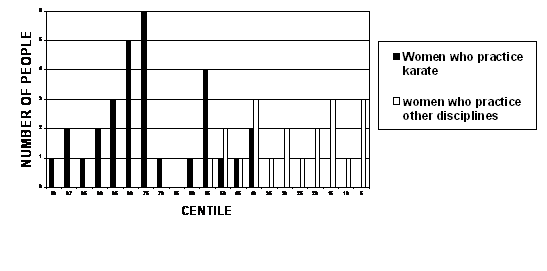
Bar chart. 1. The results of examinations among women who practice karate and other disciplines
Comparing the results of the level of assertiveness gained among women who practice karate and those who practice other sport disciplines, it can be unambiguously concluded that women who are into karate are characterized by a far more higher level of assertiveness than women who do other sports. The assertiveness declared by women who practice karate is at the level between 40 and 99 centiles, compared to women who do other sports disciplines who achieved results at the level between 5 and 55 centiles on the Rathus Assertiveness Scale.
Bar chart number two presents data concerning the level of assertiveness among women who practice karate and women who perform other disciplines divided taking into account the frequency of their trainings: women who train regularly (three and more times a week) and those who do it once a week.
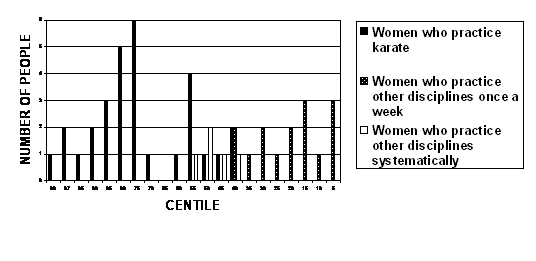
Bar chart 2. The collation of the results of assertiveness level obtained by women who practice karate and women who practice other disciplines three times a week and women who practice other disciplines once a week.
The results presented in the bar chart above, concerning women who practice other sport disciplines than karate, were divided into groups according to the number of trainings every week. It can be concluded that the number of trainings exerts a direct influence on the level of assertiveness obtained by those people. Women who practice regularly, at least three times a week or even more often, are characterized by a much higher level of assertiveness in comparison to women who practice on regular basis, but who restrict themselves to only one training every week. It should be noticed that people who practice different sport disciplines at least three times a week obtained results at the level between 40 and 55 centiles, which is only the lower borderline of the assertiveness level for people who practice karate.
Bar charts number 3 and 4 are devoted to the characteristics of the assertiveness level results obtained by men. Bar chart number 3 contains the results of assertiveness level among men who were subdivided into groups who practice karate and men who do other sport disciplines.
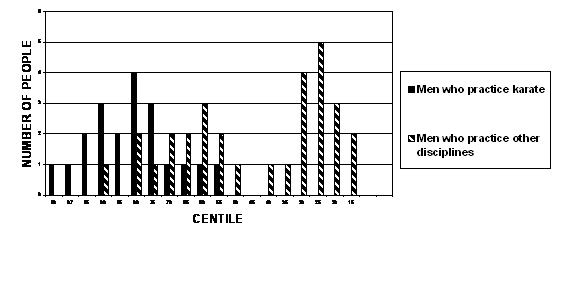
Bar chart 3. The collation of the assertiveness level of men who practice karate and men who practice other sport disciplines
The research conducted in the group comprised by men who practice karate and other sports disciplines, similarly to the group of women, show significant differences in the level of assertiveness in favour of karate adepts. The level of assertiveness among men who practice karate was between 40 and 99 centiles, while the level obtained by men who do other sport was relatively lower - from 15 to 90 centiles. A half of the men who do other sport disciplines reached the results between 15 and 40 centiles.
Bar chart number four presents data about the assertiveness level among men who practice karate and other disciplines concerning the division into men who practice regularly, at least three times a week, and those whose training takes place only once a week.
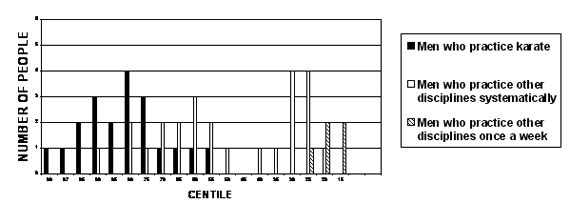
Bar chart 4. The collation of the results of assertiveness level obtained by men who practice karate and men who practice other disciplines three times a week and men who practice other disciplines once a week.
Comparing the group of men who practice different disciplines, considering the division into groups taking into consideration the frequency of training, it should be concluded that there is a huge difference in the assertiveness level in favour of men who practice sport systematically - the results oscillate between 20 and 90 centiles. Men who train only once a week obtained the result at the level between 15 do 25 centiles. It should be acknowledged that people who train other sport disciplines at least three times a week obtained lower results than men who practice karate.
Bar chart number 5 presents the collation of the results of assertiveness level taking into consideration the sex of respondents.
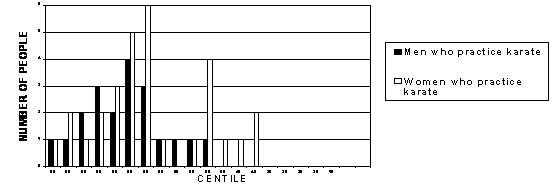
Bar chart 5. The level of assertiveness among the karate adepts surveyed considering their sex
The analysis of the results of the assertiveness level among men and women shown, that men are more assertive than women and they obtain higher results than women as well. Men’s results oscillate between 55 and 99 centiles, women’s results are between 40 and 99 centiles.
The last bar chart is a collation of the assertiveness level among people who practice other sport disciplines considering their sex.
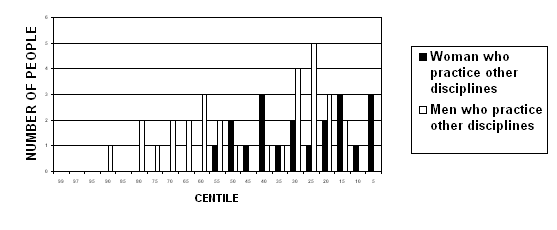
Bar chart 6. The results of the assertiveness among women and men who practice other sport disciplines
The analysis of the results of assertiveness among women and men who practice different sport disciplines revealed that men are more assertive in comparison to women and they achieve higher results than women as well. The results of men’s assertiveness oscillates between 15 and 90 centiles, women’s assertiveness oscillates between 5 and 55 centiles.
The comparison of own research to norms and results.
Questionnaire form based on the Rathus Assertiveness Scale was applied as the tool in this research, whereas each question posed to the respondents was presented on a scientific scale. The scale accepted (3 - yes it definitely refers to me; 2 - refers to me; 1 - rather refers to me; -1 - rather does not refer to me; -2 - does not refer to me; -3 - definitely does not refer to me) was used to examine the respondents’ attitudes and reactions to those situations in which assertiveness can be manifested. The differentiation gave the researchers an ample opportunity to quantify disparities in the meaning of particular terms among people who practice karate. It facilitated the process of determining the emotional component of attitudes towards different objects, gave an opportunity to asses the intensity of different emotional components of assertiveness and its cognitive structure.
Table 2 contains the results concerning the level of assertiveness among women who practice karate and those who practice other disciplines compared with norms.
Table 2.
The collation of the results obtained by women who practice karate and women who practice other disciplines
|
Results (points) |
Centile |
Number of women in the research |
|
|
Women who practice karate actively |
Women who practice other disciplines |
||
|
55 48 45 37 31 26 23 19 17 14 11 8 6 2 -1 -4 -8 -13 -17 -24 -34 |
99 97 95 90 85 80 75 70 65 60 55 50 45 40 35 30 25 20 15 10 5 |
1 2 1 2 3 5 6 1 1 4 1 1 2 |
1 2 1 3 1 2 1 2 3 1 3 |
Table number three contains data concerning the level of assertiveness among women who practice karate and women who practice other sport disciplines. The data is divided into respondents who train regularly - at least three times a week, and those who train once a week. The results are presented both in points and centiles.
Table 3.
The comparison of results obtained by women who practice karate and women who practice other disciplines (with the division into groups which train at least three times a week and once a week)
|
Results (points). |
Centile |
Number of women in the research |
||
|
Women who practice karate |
Women who practice other disciplines (at least three times a week) |
Women who practice other disciplines once a week |
||
|
55 48 45 37 31 26 23 19 17 14 11 8 6 2 -1 -4 -8 -13 -17 -24 -34 |
99 97 95 90 85 80 75 70 65 60 55 50 45 40 35 30 25 20 15 10 5 |
1 2 1 2 3 5 6 1 1 4 1 1 2
|
1 2 1 1
|
2 1 2 1 2 3 1 3 |
Table four presents the results of the assertiveness level among men with the division into men who practice karate and other sport disciplines. The results are presented both in points and in centiles.
Table 4.
The results among men who practice karate and other sport disciplines
|
Results (points). |
Centile |
Number of men in the research |
|
|
Men who practice karate actively |
Men who practice other disciplines |
||
|
65 54 49 40 33 30 26 24 19 17 15 11 8 6 3 1 -3 -7 -11 |
99 97 95 90 85 80 75 70 65 60 55 50 45 40 35 30 25 20 15 |
1 1 2 3 2 4 3 1 1 1 1
|
1 2 1 2 2 3 2 1 1 1 4 5 3 2 |
Table number five contains data concerning the level of assertiveness among men who practice karate and men who practice other sport disciplines. The data is divided into respondents who train regularly - at least three times a week, and those who train once a week. The results are presented both in points and centiles.
Table 5.
The comparison of results obtained by men who practice karate and men who practice other disciplines (with the division into groups which train at least three times a week and once a week)
|
Results (points). |
Centile |
Number of men in the research |
||
|
Men who actively practice karate |
Men who practice other disciplines at least three times a week |
Men who practice other disciplines once a week |
||
|
55 48 45 37 31 26 23 19 17 14 11 8 6 2 -1 -4 -8 -13 -17 -24 -34 |
99 97 95 90 85 80 75 70 65 60 55 50 45 40 35 30 25 20 15 10 5 |
1 1 2 3 2 4 3 1 1 1 1
|
1 2 1 2 2 3 2 1 1 1 4 4 1 |
1 2 2 |
Table six presents a collation of results of the assertiveness level among people who practice karate considering sex. The results are presented both in points and centiles.
Table 6.
Comparison of results obtained by women and men who practice karate
|
Results (points) |
Centile |
Number of men and women in the research |
|
|
Women who practice karate actively |
Men who practice karate actively |
||
|
65 54 49 40 33 30 26 24 19 17 15 11 8 6 3 1 -3 -7 -17 |
99 97 95 90 85 80 75 70 65 60 55 50 45 40 35 30 25 20 15 |
1 2 1 2 3 5 6 1 1 4 1 1 2
|
1 1 2 3 2 4 3 1 1 1 1 |
The last table presents a collation of the results of assertiveness level among people who practice other sport disciplines considering sex. The results are presented both in centiles and points.
Table 7.
The results obtained by men and women who practice other sport disciplines
|
Results (points) |
Centile |
Number of men and women in the research |
|
|
Women who practice other disciplines |
Men who practice other disciplines |
||
|
65 54 49 40 33 30 26 24 19 17 15 11 8 6 3 1 -3 -7 -17 - 24 |
99 97 95 90 85 80 75 70 65 60 55 50 45 40 35 30 25 20 15 10 |
1 2 1 3 1 2 1 2 3 1 3 |
1 2 1 2 2 3 2 1 1 1 4 5 3 2 |
The results of the research presented in centiles on the Rathus Assertiveness Scale show us how many points were gained by the respondents in the questionnaires, and at which level of assertiveness the obtained results are on the centile scale. For instance, if women obtained 45 points, it means that her result exceeds the results of 95% of women from the standardization sample. It means that the assertiveness of such a person is higher than the assertiveness of 95% of statistical women.
As the results of the research conducted in a group of 100 people, in this 50 people who practice karate, show that the results are distributed differently.
It is an undeniable regularity that the level of assertiveness among people who practice karate is higher in comparison to people who do other sports. Karate doers, both men and women obtained better results compared to the second group of sportsmen/women. This regularity can be observe among men, but it is more perceptible among women. Generally speaking, it can be stated that people who practice karate are far more assertive than other people. The results of the research conducted among people who train other disciplines three times a week or more frequently and those who train regularly but only once a week show, that the first group of people is more assertive than the second group mentioned. The result show that the practice of any sport discipline results in a higher level of assertiveness, in comparison to people who do not practice any sport discipline.
Assertiveness is nowadays a trendy word which is used very often. One can get the impression that it is overused, wrongly applied and misunderstood. Nevertheless the term penetrates into people’s lives and functions in interpersonal contacts.
The outline of the term presented in this paper and the short explanation of the assertive theory aim to bring the issue to people who actively and regularly do sport. Particularly, we think here about one sport discipline which is karate.
The aspects which entwine karate and assertiveness is showed in the above considerations. The examination conducted among a representative sample of 100 people showed that people who practice karate are more assertive than people who practice other sport disciplines. Is therefore karate a road to a better self-qualification, to find a place in the contemporary world? The results of the research tend to indicate that a different, philosophical attitude toward sport is a factor which helps a human being to find themselves in the hectic, complicated society we live in. It shows us the way to care about ourselves thanks to special educational methods and frequent trainings.
Hence, karate is not only a marital art, but also, and maybe first and foremost, a road to a better, more respectful life.
References
1. Fensterheim H., Baer J. Nie mów "TAK", gdy chcesz powiedzieć "NIE. Wydawnictwo Uniwersytetu Warszawskiego, Warszawa. 1999, 120 p.
2. Król-Fijewska M. Trening asertywności, Wydawnictwo Naukowe PWN, Warszawa. 1993. 160 p.
3. Nakayama M. Dynamiczne karate, Wydawnictwo Diamond Books, Bydgoszcz. 1999, 200 p.
4. Prusik Ka., Kochanowicz K. Kontrola sprawności specjalnej zawodników uprawiających dyscypliny o złożonej koordynacji ruchowej. W.: Kierunki doskonalenia treningu i walki sportowej: diagnostyka, (red. Anna Kuder, Krzysztof Perkowski, Dariusz Śledziewski), Warszawa, PTNKF, 2006T. 3, s. 91-94.
5. Prusik Ka., Prusik Krz., Görner K., Michałowska M. (2009) Motives and barriers to taking up physical activity by the older adults participating In the health training program. W.: Cultural behaviors conditioning wellness (red. Andrzej Wolski). Wydawnictwo: NeuroCentrum Lublin, s. 223-235.
6. Rathus S. Psychologia współczesna: lepiej, więcej, przystępniej, Gdańskie Wydawnictwo Psychologiczne, Gdańsk, 2004240 p.
7. Sęk H. Psychologiczny kontekst problemów społecznych, Wydawnictwo Fundacji Humaniora, Warszawa 1999/ 240 p/
Информация об авторах:
Шарк-Ецкардт Мирослава
rektor@ukw.edu.pl
Университет Казимира Великого в Быдгощ
ул. Ходкевича 30, г.Быдгощ 85-064, Польша.
Голебиевски Петр
rektor@ukw.edu.pl
Польский союз каратэ
ул. Ходкевича 30, г.Быдгощ 85-064, Польша.
Чеслицка Мирослава
rektor@ukw.edu.pl
Университет Казимира Великого в Быдгощ
ул. Ходкевича 30, г.Быдгощ 85-064, Польша.
Станкевич Блазей
rektor@ukw.edu.pl
Университет Казимира Великого в Быдгощ
ул. Ходкевича 30, г.Быдгощ 85-064, Польша.
Поступила в редакцию 10.04.2012г.
Information about the authors:
Szark-Eckardt Miroslawa
rektor@ukw.edu.pl
Kazimierz Wielki University in Bydgoszcz
Chodkiewicza str. 30, 85-064 Bydgoszcz, Poland.
Golebiewski Piotr
rektor@ukw.edu.pl
Polish Union of Karate
Chodkiewicza str. 30, 85-064 Bydgoszcz, Poland.
Cieslicka Miroslawa
rektor@ukw.edu.pl
Kazimierz Wielki University in Bydgoszcz
Chodkiewicza str. 30, 85-064 Bydgoszcz, Poland.
Stankiewicz Blazej
rektor@ukw.edu.pl
Kazimierz Wielki University in Bydgoszcz
Chodkiewicza str. 30, 85-064 Bydgoszcz, Poland.
Came to edition 10.04.2012.